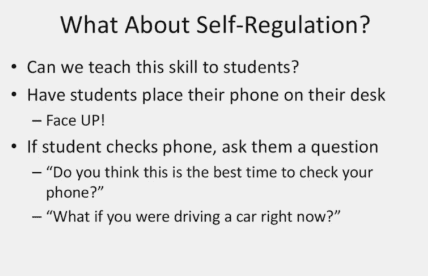Managing Smartphone Distractions in the Classroom
Technology has become an integral element in our students’ educational journey. With the influx of diverse and multimedia instruction technology software and 1:1 programs, students have access to technology both in and out of school settings. Laptops, Chromebooks, iPads, and even cell phones are providing students with opportunities to access the internet for researching, communicating and social learning. Classroom teachers are embracing the technology as a means to provide immediate feedback, assess student understanding and interact with both parents and students. However, what classroom teachers are not embracing is the increased number of discipline issues in classrooms related to an increased level of student distraction due to cell phone use. In a recent edWeb.net edWebinar, Shannon Holden, Principal at Pierce City High School in Missouri, addresses this very issue by answering the question “how are we monitoring cell phones in our classroom and aren’t devices supposed to help?”
The Research
Research from Asurion (2017) found that Americans check their phones every 12 minutes. Holden and students in his district set out to find out if this research pertained to students and if these devices are disrupting the classroom. Using charts, sixth-grade students collected cell phone usage data and recorded every time a student received a notification from social media apps and texts from family and friends. Of the 20 students who participated in the study, there were recorded 7,800 notifications, averaging one notification per student every eight minutes. These results are reinforced by research done on The Impact of Mobile Phone Use on Students Learning (2013) which states that students not using cell phones wrote an average of 62% more in their notes, wrote more detailed notes, recalled more detailed info and scored a letter and a half higher on assessment. All the cell phone usage research and the study done by Pierce City sixth graders substantiates that students engage in more off-task behavior, have higher concentration and focus issues, and that there is the potential to cause detrimental physical and mental health issues.
The Solutions
School districts across the world are taking a wide range of approaches to the student cell phone problems in schools. According to a recent survey from the National Center for Education Statistics, the percentage of public schools that banned cell phones and other mobile devices decreased from 91% in 2010 to 66% in 2016. On the other side of the spectrum, places such as France and Ontario are banning cell phones altogether and U.S. states such as California and Utah have proposed banned cell phone legislation.
While legislation and strict or relaxed cell phone policies have good intentions, students are getting around cell phone restrictions or bans by finding ingenious ways to conceal their cell phone use when listening to music, watching a video, checking social media or texting friends. These creative methods include cordless earbuds, smart watches, Bluetooth speakers, long hair and hoodies. They are also using positional strategies such as putting their head in their hands, rummaging through their backpacks and using the restroom break as an opportunity to text. In an attempt to curb or discontinue cell phone use in classrooms, school districts and classroom teachers are putting into practice consequences for students who violate school cellphone policies. Some of these repercussions, while in theory are good, can have implications for the classroom teacher or school district. Outcomes such as cell phone confiscation and cell phone jamming devices can have legal ramifications while options such as magnetic cell pouches for student devices can be costly.
So how do we monitor cell phone use and keep students off their phones without taking them away? Holden recommends classroom teachers implement inexpensive techniques such as calculator caddies, shoe organizers, freezer bags, paper bags, and plastic bags. Students turn off or put their cell phones into airplane mode, place them in these caddies or organizers and retrieve them at the end of class. Student can also be required to keep their phone in their backpacks or under their desks using the freezer, paper or plastic bags. Other techniques that teach students self-regulation skills include students placing their phones on their desk and if they do check phone, ask them the question “do you think this is the best time to check your phone and what if you were driving a car right now?” A tech break technique developed by Kliff Kingsbury, the new head coach of Arizona Cardinals can work for both students and adults. By giving players a 10-minute tech break every hour to check their phones, Kingsbury discovered that the break is cutting down on distractions and reducing players’ anxiety. No matter which technique teachers use, Holden reminds that the ultimate goal of cell phone monitoring techniques is the education of our students on positive usage of cell phones. However, he cautions that while these strategies and techniques are useful for getting student phone use under control, they may conflict with building or district policies. It is imperative for classroom teachers to check with the administration before implementing any of these techniques.
This edWeb broadcast was hosted by edWeb.net.
This article was modified and published by EdScoop.
About the Presenter
Shannon Holden, Principal at Pierce City High School in Missouri, is the TechTools for the Classroom and Teacher HELP! edWebinar and community host. Shannon served as an assistant principal for 20 years in Texas and Missouri, has taught high school history and math, and was an online instructor at the university level. Shannon presents frequently to teachers and administrators about classroom management, maintaining positive relationships with parents, instructional strategies that engage students, and implementing technology in the classroom.
Join the Community
Teacher HELP! is a free professional learning community on edWeb.net that helps teachers get advice, support, and share experiences about teaching.





Comments are closed.